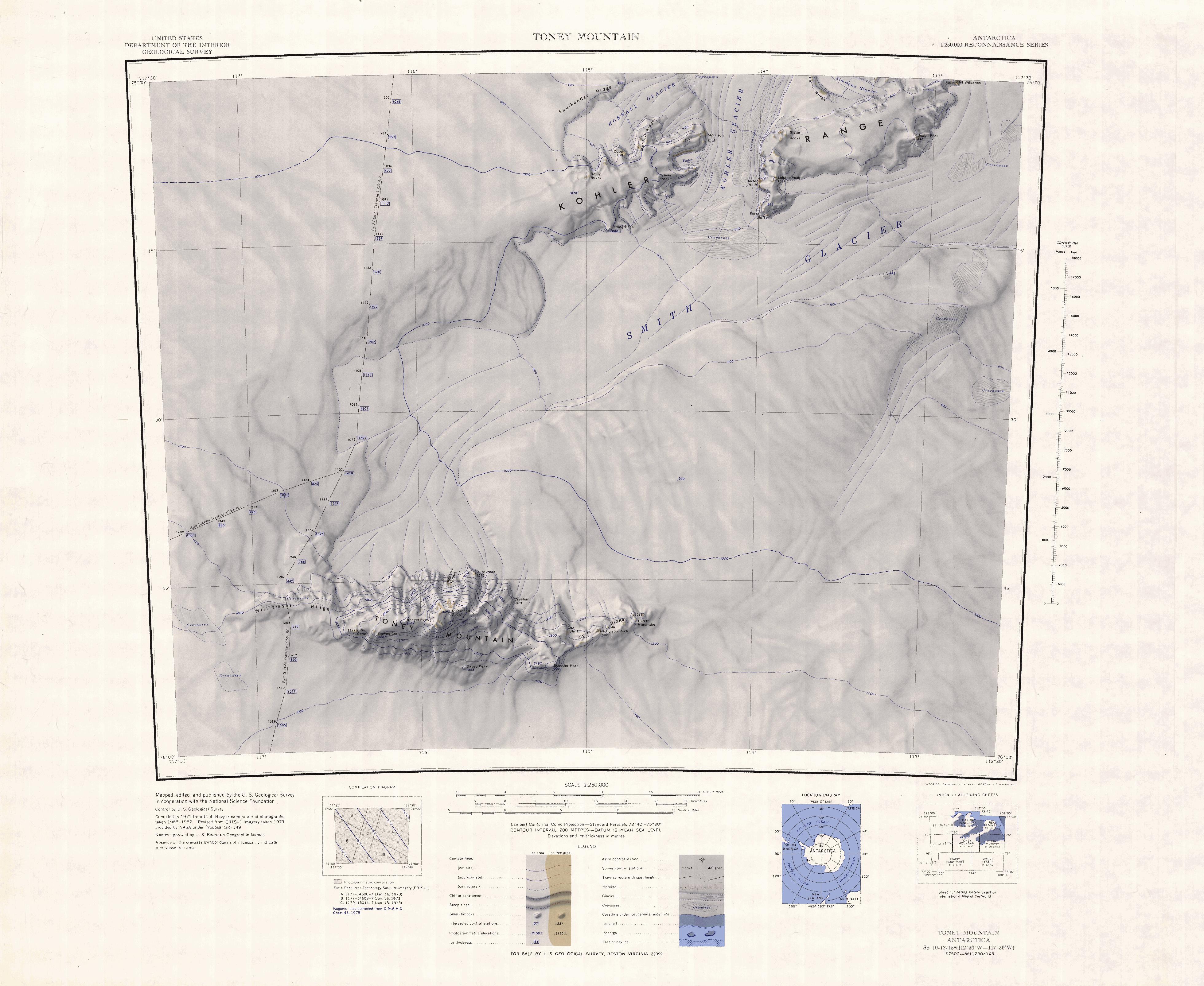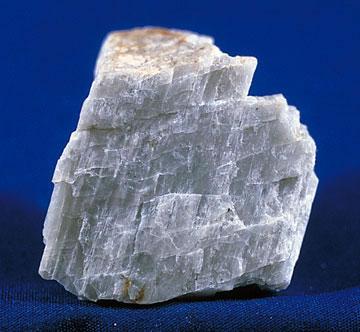|
Toney Mountain
Toney Mountain () is an elongated snow-covered shield volcano, long and rising to at Richmond Peak, located southwest of Kohler Range in Marie Byrd Land, Antarctica. Geology Toney Mountain is an elongated volcanic massif that rises - above the ice and may be Antarctica's tallest volcano. The area covered by Toney Mountain is about and is a basaltic lava plateau. A wide summit caldera tops the volcano, and is elongated in east–west direction; this orientation is shared with calderas on other volcanoes in Marie Byrd Land and reflects regional tectonic stress. The slopes of the volcano feature parasitic vents and glacial corries, and are much steeper north of the volcano than south of it. Most of the mountain is covered by ice and its eastern sector may be a crater. That the mountain is mostly ice covered makes it difficult to determine its composition, the origin of the elongated shape of the volcano and the volcanological relation between the parasitic cinder cones an ... [...More Info...] [...Related Items...] OR: [Wikipedia] [Google] [Baidu] |
Kohler Range
Kohler Range () is a mountain range in Marie Byrd Land, Antarctica. The range is about long and stands between the base of Martin Peninsula and Smith Glacier. The range consists of two ice-covered plateaus punctuated by several rock peaks and bluffs. The plateaus are oriented East-West and are separated by the Kohler Glacier, a distributary which flows north from Smith Glacier. Location The Kohler Range is south of the Martin Peninsula, which separates the Getz Ice Shelf to the west from the Dotson Ice Shelf to the east. It is north of the Smith Glacier, which flows in a northeast direction from Toney Mountain to the Dotson Ice Shelf. The Kohler Glacier, a distributary of the Smith Glacier, flows north through the range, dividing it in two, and joins the Maumee Ice Piedmont. It is joined from the west by the Yoder Glacier. The Horrall Glacier, a tributary of the Kohler Glacier, runs east through the north of the range to join the Kohler Glacier. The Simmons Glacier flo ... [...More Info...] [...Related Items...] OR: [Wikipedia] [Google] [Baidu] |
Marie Byrd Land
Marie Byrd Land (MBL) is an unclaimed region of Antarctica. With an area of , it is the largest unclaimed territory on Earth. It was named after the wife of American naval officer Richard E. Byrd, who explored the region in the early 20th century. The territory lies in West Antarctica, east of the Ross Ice Shelf and the Ross Sea and south of the Pacific Ocean portion of the Antarctic or Southern Ocean, extending eastward approximately to a line between the head of the Ross Ice Shelf and Eights Coast. It stretches between 158°W and 103°24'W. The inclusion of the area between the Rockefeller Plateau and Eights Coast is based upon Byrd's exploration. Overview Because of its remoteness, even by Antarctic standards, most of Marie Byrd Land (the portion east of 150°W) has not been claimed by any sovereign state. It is by far the largest single unclaimed territory on Earth, with an area of , including Eights Coast, immediately east of Marie Byrd Land. In 1939, United States ... [...More Info...] [...Related Items...] OR: [Wikipedia] [Google] [Baidu] |
Benmoreite
Benmoreite is a volcanic rock of intermediate composition. It is a silica-undersaturated sodium-rich variety of trachyandesite (the other kind is latite) and belongs to the alkaline suite of igneous rocks. It was named after Ben More, a mountain on the Isle of Mull, Scotland. Benmoreite has been found, for example, on Ascension Island and Easter Island, at Mount Berlin in Antarctica, and in Atakor volcanic field, Algeria. Benmoreite lava was erupted during the 2010 eruptions of Eyjafjallajökull. An origin by fractionation from basanite through nepheline hawaiite to nepheline benmoreite has been demonstrated for a volcanic suite in the McMurdo Volcanic Group of late Cenozoic age in McMurdo Sound area of Antarctica. Nepheline benmoreite magmas derived from mantle sources, containing lherzolite xenoliths, display similarities to some plutonic nepheline syenite Nepheline syenite is a holocrystalline Intrusion, plutonic rock that consists largely of nepheline and alkal ... [...More Info...] [...Related Items...] OR: [Wikipedia] [Google] [Baidu] |
Mount Takahe
Mount Takahe is a snow-covered shield volcano in Marie Byrd Land, Antarctica, from the Amundsen Sea. It is a mountain with parasitic vents and a caldera up to wide. Most of the volcano is formed by trachytic lava flows, but hyaloclastite is also found. Snow, ice, and glaciers cover most of Mount Takahe. With a volume of , it is a massive volcano; the parts of the edifice that are buried underneath the West Antarctic Ice Sheet are probably even larger. It is part of the West Antarctic Rift System along with 18 other known volcanoes. The volcano was active in the Quaternary period. Radiometric dating has yielded ages of up to 300,000years for its rocks, and it reached its present height about 200,000years ago. Several tephra layers encountered in ice cores at Mount Waesche and Byrd Station have been attributed to Mount Takahe, although some of them were later linked to eruptions of Mount Berlin instead. The tephra layers were formed by explosive or phreatomagmatic eruptions. M ... [...More Info...] [...Related Items...] OR: [Wikipedia] [Google] [Baidu] |
Byrd Station
The Byrd Station is a former research station established by the United States during the International Geophysical Year by U.S. Navy Seabees during Operation Deep Freeze II in West Antarctica. It was a year-round base until 1972, and then seasonal up to 2005. The station was built in 1957, and is located on the West Antarctic ice cap. It was accessible by overland ice traverse or by ski-equipped C-130 aircraft. History A joint Army, Navy, Air Force, and Marines operation supported an overland tractor train traverse that left out of Little America V in late 1956 to establish the station. The train was led by Army Major Merle Dawson and completed a traverse of over unexplored country in Marie Byrd Land to blaze a trail to a spot selected beforehand. The station consisted of a set of four prefabricated buildings and was erected in less than one month by U.S. Navy Seabees. It was commissioned on January 1, 1957. The original station ("Old Byrd") lasted about four years befo ... [...More Info...] [...Related Items...] OR: [Wikipedia] [Google] [Baidu] |
Volcanic Ash
Volcanic ash consists of fragments of rock, mineral crystals, and volcanic glass, produced during volcanic eruptions and measuring less than 2 mm (0.079 inches) in diameter. The term volcanic ash is also often loosely used to refer to all explosive eruption products (correctly referred to as '' tephra''), including particles larger than 2 mm. Volcanic ash is formed during explosive volcanic eruptions when dissolved gases in magma expand and escape violently into the atmosphere. The force of the gases shatters the magma and propels it into the atmosphere where it solidifies into fragments of volcanic rock and glass. Ash is also produced when magma comes into contact with water during phreatomagmatic eruptions, causing the water to explosively flash to steam leading to shattering of magma. Once in the air, ash is transported by wind up to thousands of kilometres away. Due to its wide dispersal, ash can have a number of impacts on society, including animal a ... [...More Info...] [...Related Items...] OR: [Wikipedia] [Google] [Baidu] |
Holocene
The Holocene () is the current geologic time scale, geological epoch, beginning approximately 11,700 years ago. It follows the Last Glacial Period, which concluded with the Holocene glacial retreat. The Holocene and the preceding Pleistocene together form the Quaternary period. The Holocene is an interglacial period within the ongoing Ice age, glacial cycles of the Quaternary, and is equivalent to Marine isotope stages, Marine Isotope Stage 1. The Holocene correlates with the last maximum axial tilt towards the Sun of the Earth#Axial tilt and seasons, Earth's obliquity. The Holocene corresponds with the rapid proliferation, growth, and impacts of the human species worldwide, including Recorded history, all of its written history, technological revolutions, development of major civilizations, and overall significant transition towards urban culture, urban living in the present. The human impact on modern-era Earth and its ecosystems may be considered of global significance for th ... [...More Info...] [...Related Items...] OR: [Wikipedia] [Google] [Baidu] |
Feldspar
Feldspar ( ; sometimes spelled felspar) is a group of rock-forming aluminium tectosilicate minerals, also containing other cations such as sodium, calcium, potassium, or barium. The most common members of the feldspar group are the ''plagioclase'' (sodium-calcium) feldspars and the ''alkali'' (potassium-sodium) feldspars. Feldspars make up about 60% of the Earth's crust and 41% of the Earth's continental crust by weight. Feldspars crystallize from magma as both intrusive and extrusive igneous rocks and are also present in many types of metamorphic rock. Rock formed almost entirely of calcic plagioclase feldspar is known as anorthosite. Feldspars are also found in many types of sedimentary rocks. Etymology The name ''feldspar'' derives from the German , a compound of the words ' ("field") and ("flake"). had long been used as the word for "a rock easily cleaved into flakes"; was introduced in the 18th century as a more specific term, referring perhaps to its comm ... [...More Info...] [...Related Items...] OR: [Wikipedia] [Google] [Baidu] |
Clinopyroxene
The pyroxenes (commonly abbreviated Px) are a group of important rock-forming inosilicate minerals found in many igneous and metamorphic rocks. Pyroxenes have the general formula , where X represents ions of calcium (Ca), sodium (Na), iron (Fe(II)) or magnesium (Mg) and more rarely zinc, manganese or lithium, and Y represents ions of smaller size, such as chromium (Cr), aluminium (Al), magnesium (Mg), cobalt (Co), manganese (Mn), scandium (Sc), titanium (Ti), vanadium (V) or even iron (Fe(II) or Fe(III)). Although aluminium substitutes extensively for silicon in silicates such as feldspars and amphiboles, the substitution occurs only to a limited extent in most pyroxenes. They share a common structure consisting of single chains of silica tetrahedra. Pyroxenes that crystallize in the monoclinic system are known as clinopyroxenes and those that crystallize in the orthorhombic system are known as orthopyroxenes. The name ''pyroxene'' is derived from the Ancient Greek words for ' ... [...More Info...] [...Related Items...] OR: [Wikipedia] [Google] [Baidu] |
Augite
Augite, also known as Augurite, is a common rock-forming pyroxene mineral with formula . The crystals are monoclinic and prismatic. Augite has two prominent cleavages, meeting at angles near 90 degrees. Characteristics Augite is a solid solution in the pyroxene group. Diopside and hedenbergite are important endmembers in augite, but augite can also contain significant aluminium, titanium, and sodium and other elements. The calcium content of augite is limited by a miscibility gap between it and pigeonite and orthopyroxene: when occurring with either of these other pyroxenes, the calcium content of augite is a function of temperature and pressure, but mostly of temperature, and so can be useful in reconstructing temperature histories of rocks. With declining temperature, augite may exsolve lamellae of pigeonite and/or orthopyroxene. There is also a miscibility gap between augite and omphacite, but this gap occurs at higher temperatures. There are no industrial or economic uses fo ... [...More Info...] [...Related Items...] OR: [Wikipedia] [Google] [Baidu] |
Pyroxene
The pyroxenes (commonly abbreviated Px) are a group of important rock-forming inosilicate minerals found in many igneous and metamorphic rocks. Pyroxenes have the general formula , where X represents ions of calcium (Ca), sodium (Na), iron (Fe(II)) or magnesium (Mg) and more rarely zinc, manganese or lithium, and Y represents ions of smaller size, such as chromium (Cr), aluminium (Al), magnesium (Mg), cobalt (Co), manganese (Mn), scandium (Sc), titanium (Ti), vanadium (V) or even iron (Fe(II) or Fe(III)). Although aluminium substitutes extensively for silicon in silicates such as feldspars and amphiboles, the substitution occurs only to a limited extent in most pyroxenes. They share a common structure consisting of single chains of silica tetrahedra. Pyroxenes that crystallize in the monoclinic system are known as clinopyroxenes and those that crystallize in the orthorhombic system are known as orthopyroxenes. The name ''pyroxene'' is derived from the Ancient Greek w ... [...More Info...] [...Related Items...] OR: [Wikipedia] [Google] [Baidu] |
Plagioclase
Plagioclase ( ) is a series of Silicate minerals#Tectosilicates, tectosilicate (framework silicate) minerals within the feldspar group. Rather than referring to a particular mineral with a specific chemical composition, plagioclase is a continuous solid solution series, more properly known as the plagioclase feldspar series. This was first shown by the German mineralogist Johann F. C. Hessel, Johann Friedrich Christian Hessel (1796–1872) in 1826. The series ranges from albite to anorthite endmembers (with respective compositions NaAlSi3O8 to CaAl2Si2O8), where sodium and calcium atoms can substitute for each other in the mineral's crystallography, crystal lattice structure. Plagioclase in hand samples is often identified by its polysynthetic crystal twinning or "phonograph record, record-groove" effect. Plagioclase is a major constituent mineral in Earth's crust and is consequently an important diagnostic tool in petrology for identifying the composition, origin and evolutio ... [...More Info...] [...Related Items...] OR: [Wikipedia] [Google] [Baidu] |








